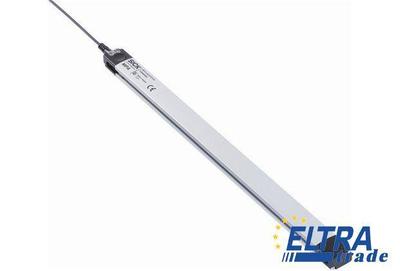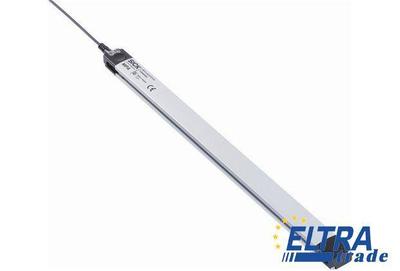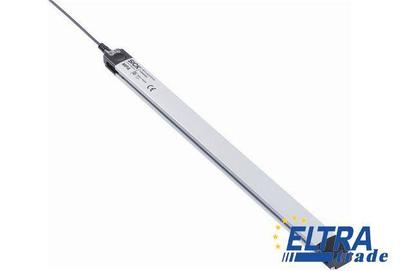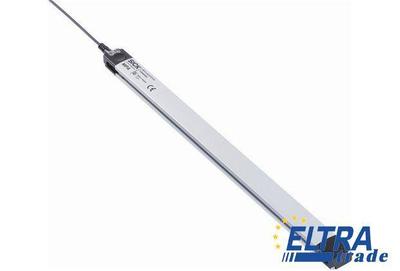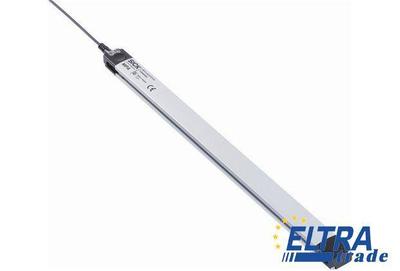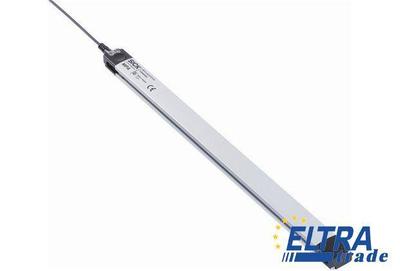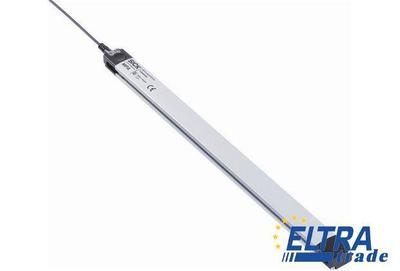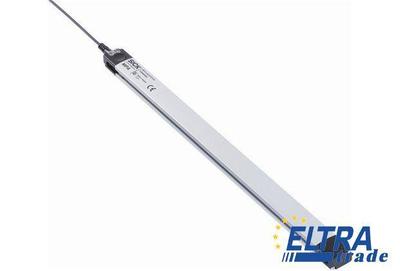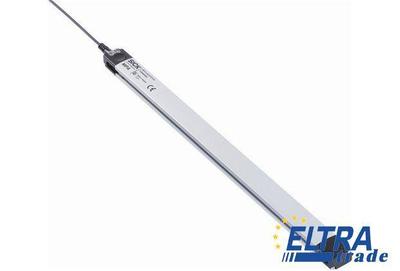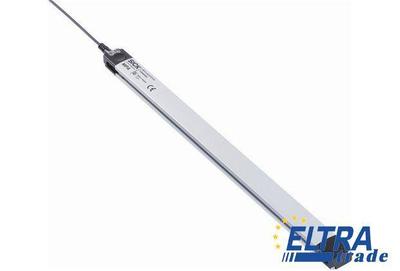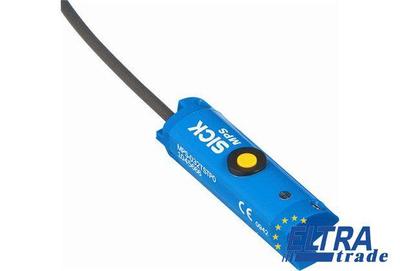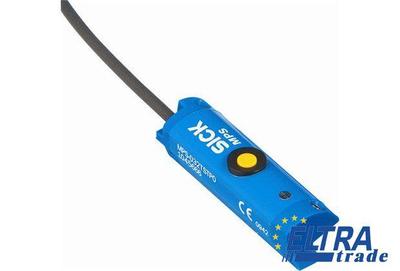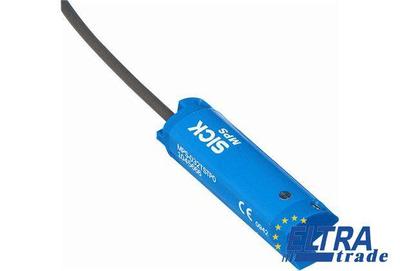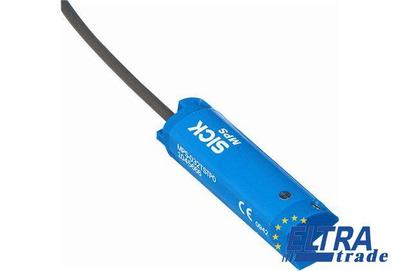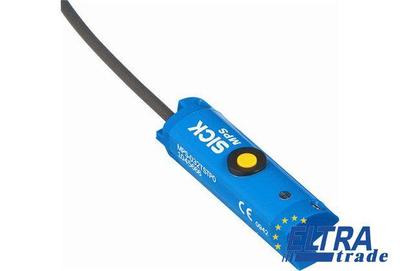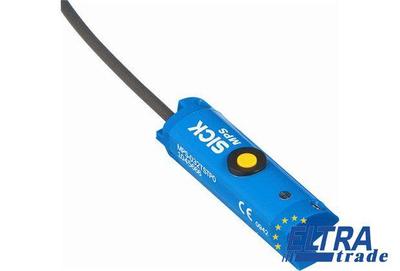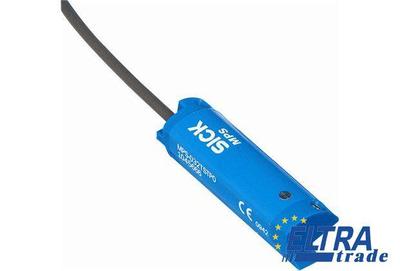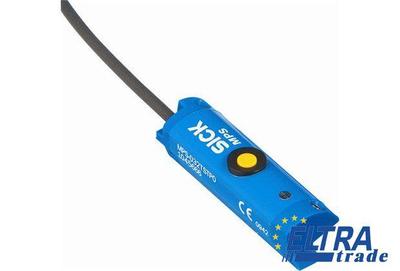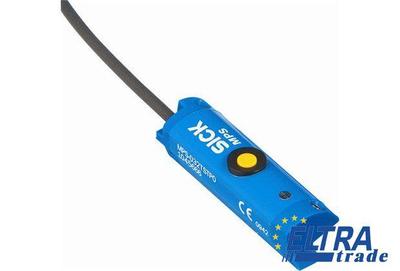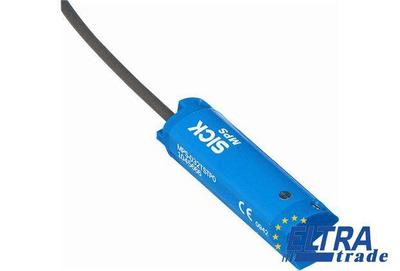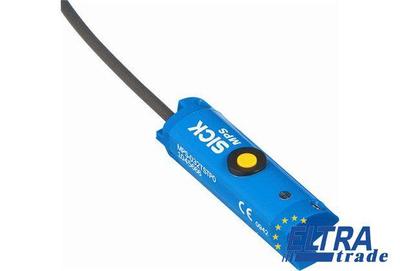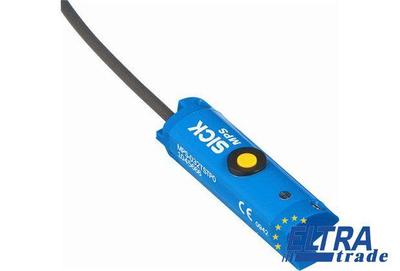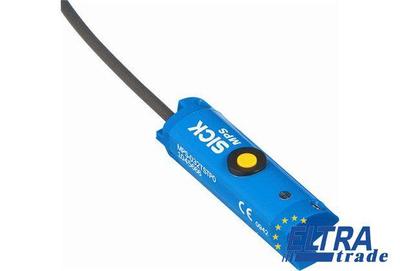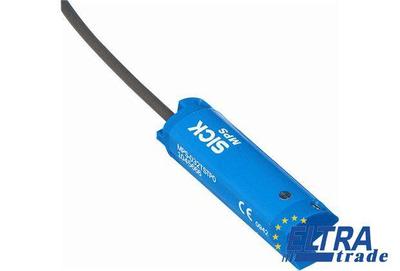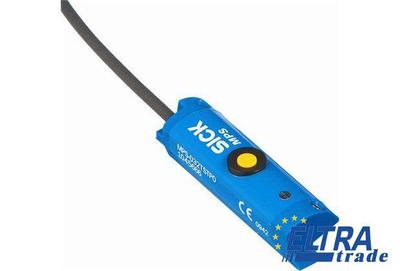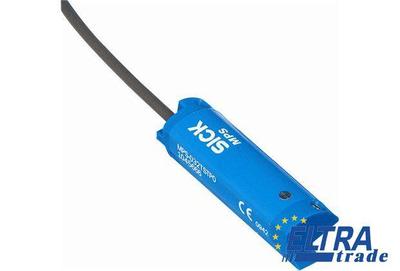Sick Magnetic Cylinder Sensors
- Output signal: analog
- 4 - 20 mA current and 0 -10 V (in one sensor)
- Superior precision: 0.05 mm resolution
- 0.1 mm repeatability
- 0.3 mm linearity
- 1 ms measurement rate
- Analog positioning sensor that can be mounted with adapters on various cylinders thanks to its universal housing, e.g., cylinders with T-slot, round and tie rod cylinders
- Measuring lengths from 107 mm to 1,007 mm in 36 mm steps
- Output signals 4 mA to 20 mA as well as 0 V to 10 V in a single sensor
- Analog positioning sensor that can be mounted with adapters on various cylinders thanks to its universal housing, e.g., cylinders with T-slot, round and tie rod cylinders
- Measuring lengths from 107 mm to 1,007 mm in 36 mm steps
- Output signals 4 mA to 20 mA as well as 0 V to 10 V in a single sensor
- Analog positioning sensor that can be mounted with adapters on various cylinders thanks to its universal housing, e.g., cylinders with T-slot, round and tie rod cylinders
- Measuring lengths from 107 mm to 1,007 mm in 36 mm steps
- Output signals 4 mA to 20 mA as well as 0 V to 10 V in a single sensor
- Analog positioning sensor that can be mounted with adapters on various cylinders thanks to its universal housing, e.g., cylinders with T-slot, round and tie rod cylinders
- Measuring lengths from 107 mm to 1,007 mm in 36 mm steps
- Output signals 4 mA to 20 mA as well as 0 V to 10 V in a single sensor
- Analog positioning sensor that can be mounted with adapters on various cylinders thanks to its universal housing, e.g., cylinders with T-slot, round and tie rod cylinders
- Measuring lengths from 107 mm to 1,007 mm in 36 mm steps
- Output signals 4 mA to 20 mA as well as 0 V to 10 V in a single sensor
- Analog positioning sensor that can be mounted with adapters on various cylinders thanks to its universal housing, e.g., cylinders with T-slot, round and tie rod cylinders
- Measuring lengths from 107 mm to 1,007 mm in 36 mm steps
- Output signals 4 mA to 20 mA as well as 0 V to 10 V in a single sensor
- Analog positioning sensor that can be mounted with adapters on various cylinders thanks to its universal housing, e.g., cylinders with T-slot, round and tie rod cylinders
- Measuring lengths from 107 mm to 1,007 mm in 36 mm steps
- Output signals 4 mA to 20 mA as well as 0 V to 10 V in a single sensor
- Analog positioning sensor that can be mounted with adapters on various cylinders thanks to its universal housing, e.g., cylinders with T-slot, round and tie rod cylinders
- Measuring lengths from 107 mm to 1,007 mm in 36 mm steps
- Output signals 4 mA to 20 mA as well as 0 V to 10 V in a single sensor
- Analog positioning sensor that can be mounted with adapters on various cylinders thanks to its universal housing, e.g., cylinders with T-slot, round and tie rod cylinders
- Measuring lengths from 107 mm to 1,007 mm in 36 mm steps
- Output signals 4 mA to 20 mA as well as 0 V to 10 V in a single sensor
- Analog positioning sensor that can be mounted with adapters on various cylinders thanks to its universal housing, e.g., cylinders with T-slot, round and tie rod cylinders
- Measuring lengths from 107 mm to 1,007 mm in 36 mm steps
- Output signals 4 mA to 20 mA as well as 0 V to 10 V in a single sensor
- Analog positioning sensor that can be mounted with adapters on various cylinders thanks to its universal housing, e.g., cylinders with T-slot, round and tie rod cylinders
- Measuring lengths from 107 mm to 1,007 mm in 36 mm steps
- Output signals 4 mA to 20 mA as well as 0 V to 10 V in a single sensor
- Analog positioning sensor that can be mounted with adapters on various cylinders thanks to its universal housing, e.g., cylinders with T-slot, round and tie rod cylinders
- Measuring lengths from 107 mm to 1,007 mm in 36 mm steps
- Output signals 4 mA to 20 mA as well as 0 V to 10 V in a single sensor
- Analog positioning sensor for pneumatic and hydraulic cylinders with T-slot
- Measuring lengths from 32 mm to 256 mm in 32 mm steps
- Output signals 4 mA to 20 mA as well as 0 V to 10 V in a single sensor
- Magnetic position sensor for pneumatic cylinders with T-slot
- Output signal: IO-Link
- Superior precision: 0.05 mm resolution, 0.1 mm repeatability, 0.3 mm linearity, 1 ms measurement rate
- Magnetic position sensor for pneumatic and hydraulic cylinders with T-slot
- Output signal: analog, 4 - 20 mA current and 0 -10 V (in one sensor)
- Superior? precision: 0.05 mm resolution, 0.1 mm repeatability, 0.3 mm linearity, 1 ms ?measurement?rate
- Magnetic position sensor for pneumatic and hydraulic cylinders with T-slot
- Output signal: analog, 4 - 20 mA current and 0 -10 V (in one sensor)
- Superior? precision: 0.05 mm resolution, 0.1 mm repeatability, 0.3 mm linearity, 1 ms ?measurement?rate
- Analog positioning sensor for pneumatic and hydraulic cylinders with T-slot
- Measuring lengths from 32 mm to 256 mm in 32 mm steps
- Output signals 4 mA to 20 mA as well as 0 V to 10 V in a single sensor
- Analog positioning sensor for pneumatic and hydraulic cylinders with T-slot
- Measuring lengths from 32 mm to 256 mm in 32 mm steps
- Output signals 4 mA to 20 mA as well as 0 V to 10 V in a single sensor
- Magnetic position sensor for pneumatic and hydraulic cylinders with T-slot
- Output signal: analog, 4 - 20 mA current and 0 -10 V (in one sensor)
- Superior? precision: 0.05 mm resolution, 0.1 mm repeatability, 0.3 mm linearity, 1 ms ?measurement?rate
- Analog positioning sensor for pneumatic and hydraulic cylinders with T-slot
- Measuring lengths from 32 mm to 256 mm in 32 mm steps
- Output signals 4 mA to 20 mA as well as 0 V to 10 V in a single sensor
- Magnetic position sensor for pneumatic cylinders with T-slot
- Output signal: IO-Link
- Superior precision: 0.05 mm resolution, 0.1 mm repeatability, 0.3 mm linearity, 1 ms measurement rate
- Magnetic position sensor for pneumatic and hydraulic cylinders with T-slot
- Output signal: analog, 4 - 20 mA current and 0 -10 V (in one sensor)
- Superior? precision: 0.05 mm resolution, 0.1 mm repeatability, 0.3 mm linearity, 1 ms ?measurement?rate
- Analog positioning sensor for pneumatic and hydraulic cylinders with T-slot
- Measuring lengths from 32 mm to 256 mm in 32 mm steps
- Output signals 4 mA to 20 mA as well as 0 V to 10 V in a single sensor
- Analog positioning sensor for pneumatic and hydraulic cylinders with T-slot
- Measuring lengths from 32 mm to 256 mm in 32 mm steps
- Output signals 4 mA to 20 mA as well as 0 V to 10 V in a single sensor
- Magnetic position sensor for pneumatic cylinders with T-slot
- Output signal: IO-Link
- Superior precision: 0.05 mm resolution, 0.1 mm repeatability, 0.3 mm linearity, 1 ms measurement rate
- Magnetic position sensor for pneumatic and hydraulic cylinders with T-slot
- Output signal: analog, 4 - 20 mA current and 0 -10 V (in one sensor)
- Superior? precision: 0.05 mm resolution, 0.1 mm repeatability, 0.3 mm linearity, 1 ms ?measurement?rate
- Analog positioning sensor for pneumatic and hydraulic cylinders with T-slot
- Measuring lengths from 32 mm to 256 mm in 32 mm steps
- Output signals 4 mA to 20 mA as well as 0 V to 10 V in a single sensor
- Analog positioning sensor for pneumatic and hydraulic cylinders with T-slot
- Measuring lengths from 32 mm to 256 mm in 32 mm steps
- Output signals 4 mA to 20 mA as well as 0 V to 10 V in a single sensor
- Magnetic position sensor for pneumatic and hydraulic cylinders with T-slot
- Output signal: analog, 4 - 20 mA current and 0 -10 V (in one sensor)
- Superior? precision: 0.05 mm resolution, 0.1 mm repeatability, 0.3 mm linearity, 1 ms ?measurement?rate
The Sick cylinder sensor is an optical device based on non-contact sensing technology. Such devices are widely used in industrial sectors where conveyor production and packaging are used.
The sensor helps find small parts of manufactured products, count objects, and control their location on the line. An example is the control of milk cartons or the detection of breakage of small parts. Below we will take a closer look at the Sick cylinder sensor series.
Features and Benefits of Sick Cylinder Sensor Series
Sick magnetic cylinder sensors are available in two main varieties.
Reed sensors
The operation of a reed sensor or reed contact is based on magnetism. In a case containing an inert gas or vacuum, there are two thin overlapping metal strips, one fixed and the other spring-loaded, which move under the influence of a magnetic field. When the piston magnet reaches the position of the sensor, it pulls the moving metal strip toward the stationary strip. This creates a closed circuit, and the reed switch generates an output signal.
Solid-state sensors
The operation of a solid-state sensor is based on a change in the resistance of the sensor due to a change in the magnetic field. A solid-state sensor is usually equipped with four so-called magnetoresistive sensors connected to a Wheatstone bridge. When a magnet in a piston of a cylinder or on a moving shaft reaches a solid-state sensor, the resistance of the individual sensors will change, and thus the bridge voltage will change. The voltage change after amplification and processing will result in an output signal from the sensor.
Benefits
Here are some of the main advantages of magnetic cylinder sensors.
- Accurate position detection.
- Improved process efficiency.
- Enhanced quality control.
- Increased safety.
- Reduced maintenance downtime.
- Flexibility and adaptability.
- Long service life.
- Integration with automation systems.
- Diagnostic capabilities.
- Environmental resistance.
- Reduced energy consumption.
Applications of Sick Cylinder Sensor Series
Let's find out in which industries cylinder sensors are most commonly used.
Proximity sensing
Cylinder sensors are often used for proximity detection tasks, such as detecting the presence or absence of objects in industrial processes. They can be used to trigger actions when an object falls within a certain sensor range.
Position detection
Subdomain devices can determine the position of moving objects or machine parts. In applications such as conveyor systems, they can determine if an object is in a certain position for further processing or packaging.
Limit switches
These sensors are typically used as limit switches to detect extreme positions of moving components, such as fully retracted or fully extended cylinder positions, to prevent overtravel.
Object counting
In manufacturing processes, cylindrical sensors can count objects as they pass by. This is often used for quality control and inventory management.
Liquid level detection
Cylinder sensors can be used to detect the level of liquid in tanks or containers. They are commonly used in industries such as chemical processing and agriculture.
Machine safety
These sensors play a role in machine safety by detecting the presence of objects or people in hazardous areas. They can trigger safety measures to prevent accidents.
Conveyor belt control
Such devices can be used to control the operation of a conveyor belt. They can detect the presence of objects on the tape and trigger actions such as stopping or deflecting the tape.
Packaging
In packaging equipment, cylindrical sensors can be used to detect the presence and position of packaging materials, enabling accurate filling and sealing processes.
Door and gate monitoring
Cylinder sensors can monitor the status of doors, gates or hatches in industrial environments, ensuring they are properly closed or locked for safety reasons.
Assembly verification
On assembly lines, cylindrical sensors can check if components are properly aligned and in the correct position before the next assembly step.
Loading and unloading works
Such sensors are used in material handling equipment to ensure the correct positioning of materials or objects during loading, unloading, or sorting.
Robotics
Such devices can provide robotic systems with feedback on the position of objects or parts, helping them perform precise manipulation and assembly tasks.
Installation and Setup of Sick Cylinder Sensors
Below we want to present you some tips for installing and configuring Sick cylinder sensors.
- Begin by carefully reading the user manual, datasheet, and any other documentation provided by Sick for your specific sensor model.
- Determine the optimal location for installing the sensor.
- Make sure the mounting surface is clean, level, and suitable for secure mounting of the sensor.
- Attach the sensor cylinder to the mounting surface using the recommended mounting hardware.
- Connect the required wiring to the sensor. Usually this includes connecting power, ground and signal wires in accordance with the connection diagram provided in the documentation.
- Provide the sensor with the correct supply voltage according to the specifications.
- After installation and configuration, perform thorough testing to ensure that the sensor accurately detects movement or position.

